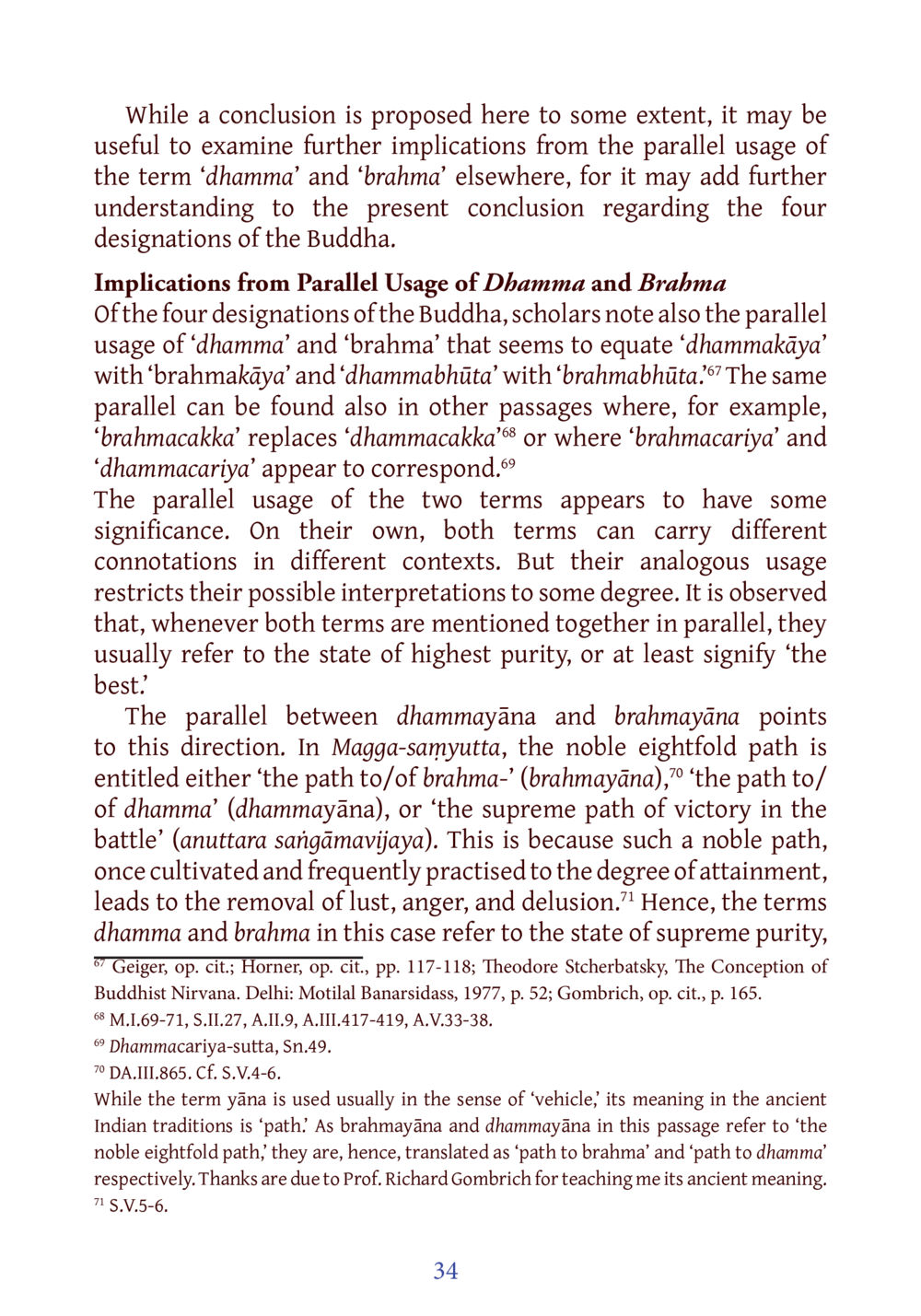Implications of Dhamma and Brahma in Buddhist Teachings : หน้า 55/141
DIRI Journal : หน้า 55/141 Exploring the parallel usage of 'dhamma' and 'brahma' in Buddhist texts and its significance in understanding the Buddha's designations.
3 ครั้ง

สรุปเนื้อหา
เนื้อหานี้สำรวจการใช้คำว่า 'ดัมมะ' และ 'บราเหมะ' ในวรรณกรรมพุทธศาสนา และการตีความความหมายที่เชื่อมโยงกันของทั้งสองคำ เป็นการศึกษาความสำคัญของการใช้คำที่ขนานกัน ซึ่งสะท้อนถึงสถานะความบริสุทธิ์สูงสุดที่เกี่ยวข้องกับพระพุทธเจ้าผ่านหลักธรรมและแนวทางปฏิบัติอย่างมีความหมาย การใช้คำทั้งสองในข้อความที่ขนานกันช่วยจำกัดการตีความไปในทิศทางที่ชัดเจนยิ่งขึ้น อาทิ การเปรียบเทียบระหว่าง 'ดัมมะยาน' และ 'บราเหมะยาน' ที่ชี้ให้เห็นถึงการทำให้หลายคำมีความหมายในลักษณะเดียวกันและมีความสำคัญต่อการเข้าใจในทางปฏิบัติอย่างสูงสุด
หัวข้อประเด็น
-การใช้คำดัมมะและบราเหมะ
-ความสัมพันธ์ระหว่างพระพุทธเจ้าและหลักธรรม
-การเข้าใจความบริสุทธิ์ในพุทธศาสนา
-การตีความคำในทางปฏิบัติ
-ดัมมะยานและบราเหมะยานในสังเวียน
ข้อความต้นฉบับในหน้า
While a conclusion is proposed here to some extent, it may be useful to examine further implications from the parallel usage of the term 'dhamma' and 'brahma' elsewhere, for it may add further understanding to the present conclusion regarding the four designations of the Buddha.
Implications from Parallel Usage of Dhamma and Brahma
Of the four designations of the Buddha, scholars note also the parallel usage of 'dhamma' and 'brahma' that seems to equate 'dhammakāya' with 'brahmakāya' and 'dhammabhūta' with 'brahmabhūta.'67 The same parallel can be found also in other passages where, for example, 'brahmacakka' replaces 'dhammacakka'68 or where 'brahmacariyā' and 'dhammacariyā' appear to correspond.69 The parallel usage of the two terms appears to have some significance. On their own, both terms can carry different connotations in different contexts. But their analogous usage restricts their possible interpretations to some degree. It is observed that, whenever both terms are mentioned together in parallel, they usually refer to the state of highest purity, or at least signify 'the best.'
The parallel between dhammayāna and brahmayāna points to this direction. In Magga-saṃyutta, the noble eightfold path is entitled either 'the path to/of brahma-' (brahmayāna),70 'the path to/of dhamma' (dhammayāna), or 'the supreme path of victory in the battle' (anuttara saṅgāmavijaya). This is because such a noble path, once cultivated and frequently practised to the degree of attainment, leads to the removal of lust, anger, and delusion.71 Hence, the terms dhamma and brahma in this case refer to the state of supreme purity,
67 Geiger, op. cit.; Horner, op. cit., pp. 117-118; Theodore Stcherbatzky, The Conception of Buddhist Nirvana. Delhi: Motilal Banarsidass, 1977, p. 52; Gombrich, op. cit., p. 165.
68 M.I.69-71, S.II.27, A.II.9, A.III.417-419, A.V.33-38.
69 Dhammacariya-sutta, Sn.49.
70 DA.III.865. Cf. S.V.4-6.
While the term yāna is used usually in the sense of ‘vehicle,’ its meaning in the ancient Indian traditions is ‘path.’ As brahmayāna and dhammayāna in this passage refer to ‘the noble eightfold path,’ they are, hence, translated as ‘path to brahma’ and ‘path to dhamma’ respectively. Thanks are due to Prof. Richard Gombrich for teaching me its ancient meaning. 71 S.V.5-6.
หน้าหนังสือทั้งหมด

1

2

3

4

5

6

7

8

9

10

11

12

13

14

15

16

17

18

19

20

21

22

23

24

25

26

27

28

29

30

31

32

33

34

35

36

37

38

39

40

41

42

43

44

45

46

47

48

49

50

51

52

53

54

55

56

57

58

59

60

61

62

63

64

65

66

67

68

69

70

71

72

73

74

75

76

77

78

79

80

81

82

83

84

85

86

87

88

89

90

91

92

93

94

95

96

97

98

99

100

101

102

103

104

105

106

107

108

109

110

111

112

113

114

115

116

117

118

119

120

121

122

123

124

125

126

127

128

129

130

131

132

133

134

135

136

137

138

139

140

141
หนังสือที่เกี่ยวข้อง
Load More
